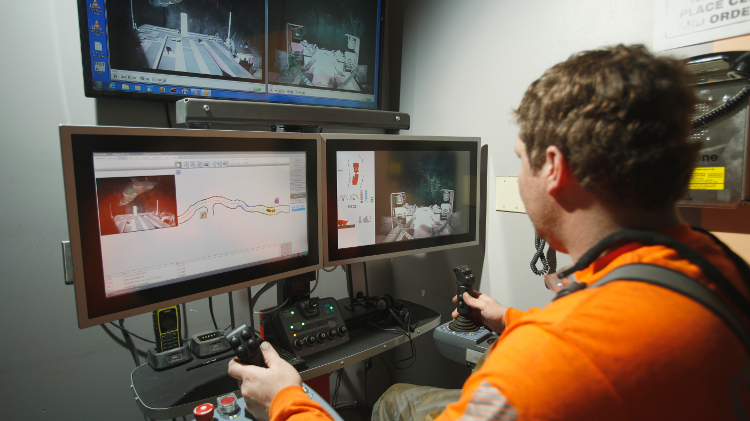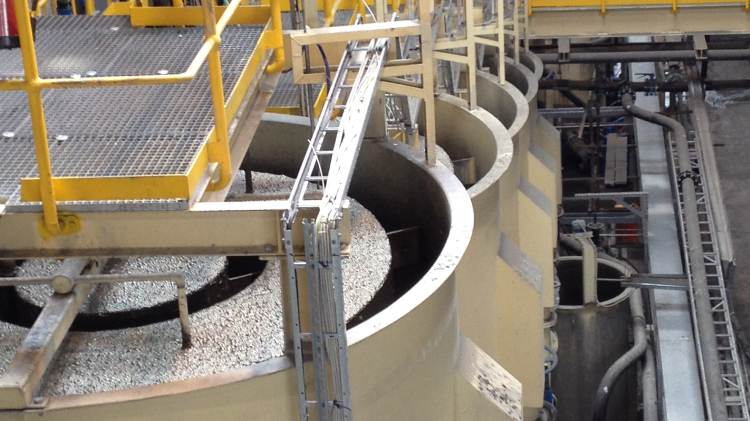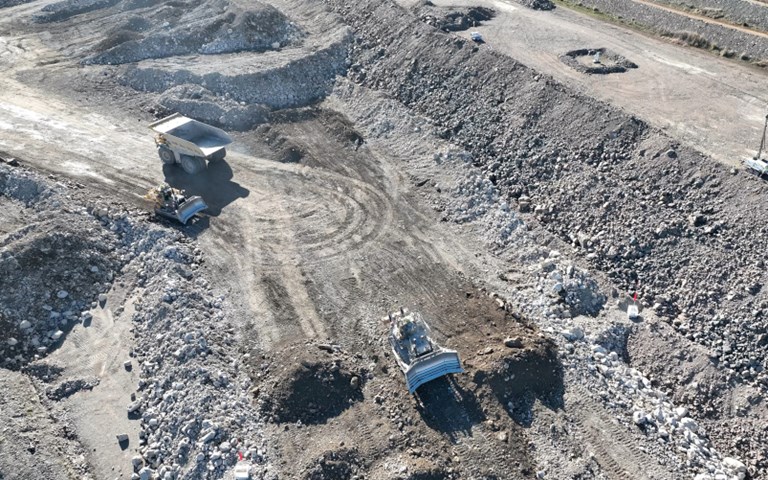Newmont has deployed Ericsson private 5G for teleremote operation of its dozers at the Cadia gold-copper mine in Australia. Courtesy of Newmont
An increasing number of digital and next-generation technologies—such as sensors, automated machinery and wireless monitoring systems—are transforming mining operations to become safer, smarter and more streamlined than ever before.
However, the success of these technologies hinges on one critical requirement: reliable connectivity.
Without a robust, connective communication network, even the most cutting-edge technologies and autonomous solutions will fail to work properly. Autonomous equipment relies on the constant exchange of data to support real-time decision-making, remote control and seamless machine-to-machine communication, whether deep underground or in open pits located in remote areas.
To meet these growing demands, mining companies are exploring a range of communication technologies tailored to their unique environments. From leaky feeder systems to private wireless 5G and dynamic mesh networks, there is no one-size-fits-all approach.
Luckily, there are several companies leading the way in developing advanced communication solutions that are supporting autonomous mining.
Continuous and constant connectivity
One type of communication solution enhancing connectivity at modern mining operations is wireless mesh networks. This technology relies on multiple interconnected devices, known as nodes, that are placed throughout mine sites and on mobile equipment, creating an overlapping mesh that does not rely on a single access point. These nodes work together to create a seamless, high-bandwidth industrial WiFi network.
Among the companies in this space, U.S.-based Rajant Corporation has developed its own kinetic mesh network that can be used in both underground and open-pit mines.
At the core of the Rajant Kinetic Mesh is InstaMesh, a proprietary wireless protocol that enables real-time, intelligent routing between its rugged wireless nodes, called BreadCrumbs. Each BreadCrumb contains one to four radio interfaces and supports standard WiFi protocols to enable voice, video and data communications across the mine.
What sets Rajant’s mesh network apart from others is its ability to deliver automatic, continuous, on-the-move connectivity, without introducing single points of failure.
Most mesh networks either require a centralized controller and a smart node that makes all the routing decisions or rely on access points to talk to each other, explained Steven Griggs, vice-president of sales engineering at Rajant. This type of set-up makes the network more vulnerable to high latency, connection dropouts and bottlenecks, particularly when mobile nodes move out of range from one another, which causes the network to disconnect and reconnect.
In contrast, Rajant’s BreadCrumbs are capable of independently discovering and maintaining multiple connections simultaneously to ensure a continuous network connection.
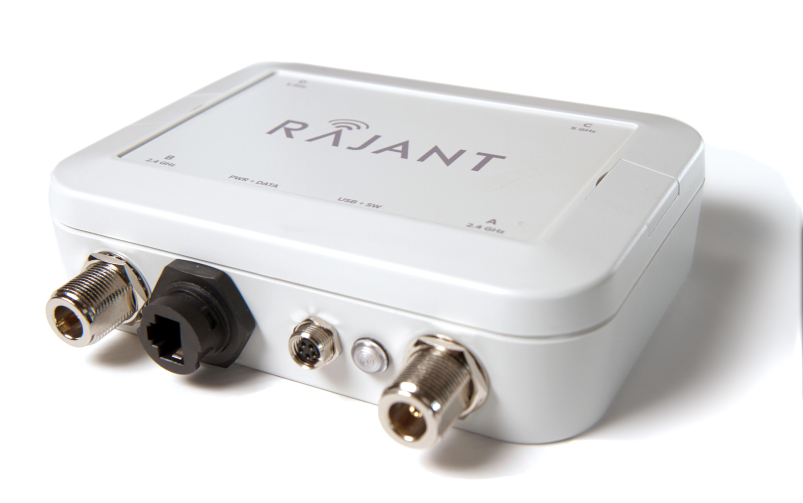 Rajant’s BreadCrumb wireless nodes form its kinetic mesh industrial wireless infrastructure. Courtesy of Rajant
Rajant’s BreadCrumb wireless nodes form its kinetic mesh industrial wireless infrastructure. Courtesy of Rajant
“Each one of our nodes is capable of making routing decisions, and that’s the real key,” said Griggs. “We don’t have to program how to mesh or how to route anything—they figure it all out on their own.”
This self-routing capability is especially vital in applications involving autonomous mining equipment.
For instance, in operations that deploy massive, driverless haul trucks, a constant, uninterrupted flow of data is crucial. “There will be interferences [with connectivity] in mines,” said Griggs. “[But] if you lose communication with a 400-tonne giant running around your mine, that’s a bad day.”
Rajant’s InstaMesh protocol reduces the risks of this happening by maintaining hundreds of simultaneous connections across infrastructure and mobile machinery. This eliminates reliance on any single device and supports maximum uptime for both the network and the autonomous machines operating on it.
“What this equates to is redundancy, and that’s the key for autonomy,” said Griggs. “Each one of those radios [in each BreadCrumb] is a path for data. It’s all redundant. So, if there’s trouble on one frequency, it can still transmit on another.”
While LTE is often considered for its long-range capabilities, Griggs said that LTE does not deliver significantly more range, and that it is a point-to-multipoint system, which means it can “still have a single point of failure.”
Rajant’s system is scalable and simple to deploy. Mines can start small and scale up to hundreds of nodes. Its largest deployment to date includes 627 nodes in the network.
It is also cost-effective over time, Griggs said. The system can last over a decade in harsh mining environments, without needing frequent upgrades or replacement. “We’ve got mines still running our entire catalogue from 2008 to now,” he said.
Additionally, he said that the Rajant Kinetic Mesh can consolidate multiple applications, such as fleet management, high-precision dozing and GPS corrections, to run under a single powerful network, whereas older systems often required separate networks for each.
This reliable, always-on connectivity has proven successful in real-world mining environments. At the Freeport-McMoRan open-pit copper mine in Bagdad, Arizona, for example, Rajant’s mesh network was integrated into an autonomous haulage system without requiring a complete overhaul of the existing network infrastructure. Similarly, Whitehaven Coal’s Maules Creek open-cut mine in northwest New South Wales, Australia, adopted Rajant’s technology for its Hitachi autonomous fleet after other systems failed to meet performance expectations.
Enabling 5G communication
In April 2025, Newmont’s Cadia underground gold-copper mine in Australia reached a major milestone it had been pursuing since 2021: the successful teleremote operation of an entire fleet of dozers.
This achievement was made possible thanks to the first-time deployment of Sweden-based telecom giant Ericsson’s private wireless 5G network (EP5G).
In the past, Newmont had tried using WiFi networks to connect its teleremote-control systems, where a single human operator would manage multiple machines at once from a distance.
However, WiFi proved insufficient because it offered limited range and security, low reliability and poor scalability when managing more than a couple of dozers at a time, according to an April 14 joint press release from Ericsson and Newmont.
Ericsson’s private 5G solution resolved these issues. As Kirstin Sym-Smith, global vertical partnership lead at Ericsson Enterprise Wireless Solutions, explained: “5G provides access to more spectrum, better capacity, faster speeds, greater uplink for efficiency and lower latency. It allows for extended range coverage.”
With the EP5G network, Newmont was able to scale its operations to support up to 12 dozers concurrently. This was a transformative step for both its mine’s productivity and operational safety.
Ericsson’s EP5G is designed for flexibility and ease of deployment. The solution integrates advanced radio technologies with a compact core network that can be deployed wherever coverage is needed on-site.
“Deployments with Ericsson’s private 5G are aimed to be simplified so they can provide seamless provisioning, configuration capabilities, unified policy management and a single pane of glass [integrating information from multiple sources into one unified visual display] across the network so the mine can view the health of their network, add users to the network, all the while not having to change a ton of complicated parameters,” said Sym-Smith.
The network also offers a range of different radio variants, from compact indoor radio dot systems for tunnel coverage, to micro radios capable of covering up to six kilometres, to macro radios for broader surface coverage.
Another key feature is its uplink booster technology, which helps transmit data from equipment back to the control centres. Ericsson’s uplink booster can extend coverage by up to 10 decibel milliwatts, which translates to nearly 90 per cent greater application coverage. At the Cadia site, for example, uplink throughput hit 175 megabits per second.
“Newmont got better uplink and definitely better connection with just having one 5G radio to support multiple dozers,” said Sym-Smith. “That was a really big deal for their productivity and safety.”
EP5G also offers dual support for both 4G and LTE, allowing mining companies to adapt according to their use cases and needs. While 5G has some clear benefits, adoption does not always come easily.
“5G isn’t new in the broader public space, but it’s still relatively new in the mining world,” said Sym-Smith. “Mines are typically conservative [with spending money], so it is going to take a mine with a different mindset, [one that] is looking to be innovative and find different ways to boost productivity, enhance its safety and increase efficiency.”
Many mining operations may feel comfortable sticking with their existing WiFi or wired systems, particularly if their current needs are being met.
“There’s still room for private networks to coexist with WiFi or other technologies—it all depends on what the mine is trying to accomplish,” said Sym-Smith. “But for these advanced applications, private networks are really a must. You need a better network, and I think sometimes one thing that is overlooked in automation is the correct network infrastructure to support it.”
That being said, Sym-Smith added that she is seeing a growing interest from mines wanting to start using 5G for automation across the globe.
“This is coming from Newmont and all their markets around the world. But we’re also seeing interest in Europe, Africa, Latin America and other places,” she said. “Some are adopting this sooner than later, but it is benefiting the mines now, especially for productivity, safety and construction.”
Bridging the traditional with the new
Thunder Bay-based Turnkey Communications has a communication portfolio that spans leaky feeder systems to fibre-fed deployments, WiFi, 5G and LTE. The company’s philosophy is to use whatever works best for the client.
“We’re agnostic to solutions,” said Terry Joseph, chief executive officer of Turnkey Communications. “It’s not about pushing one system over another. We’re more about providing a solution that’s going to work for our client.”
Turnkey’s offerings include a leaky feeder system, which is a radiating coaxial cable that enables radio communication underground. It is a reliable choice that still holds strong relevance in modern deployments because of its simplicity, maintainability and adaptability, Joseph said.
He said leaky feeders are a legacy technology that has been around for over 40 years, but despite that, they have evolved significantly to keep up with other technologies.
Turnkey often combines its leaky feeder system with its private wireless network technology in order to allow for the integration of a traditional system with a more modern infrastructure.
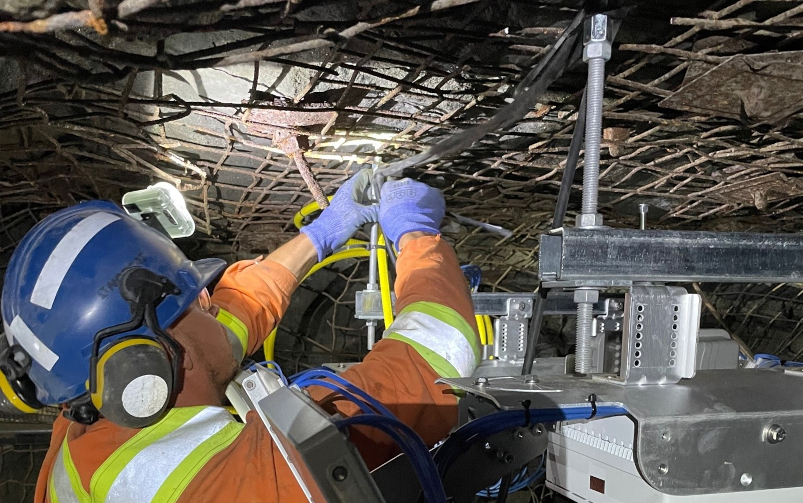 A Turnkey Communications technician installing a strand-mounted antenna. Courtesy of Turnkey Communications
A Turnkey Communications technician installing a strand-mounted antenna. Courtesy of Turnkey Communications
“There can be a standalone leaky feeder system with LTE radios and technologies, or it could be a fibre-fed system with radios and LTE capabilities, or it could be just radio frequencies alone on the leaky feeder,” explained Joseph. “There are many different variations that you can do to create network connectivity under or above ground.”
Joseph said that Turnkey understands that most existing mines already have some form of leaky feeder infrastructure in place. Instead of completely replacing the system, it helps customers build on what is already there. For instance, in a project at the NORCAT Underground Centre in Sudbury, Ontario, Turnkey worked with Rogers on a fully fibre-fed private LTE deployment, while also leveraging the mine’s existing leaky feeder system and injecting it with a private wireless network to maximize the communication coverage.
The integration of traditional communication systems with modern technologies is also enabling the adoption of automation in mines today. Leaky feeder systems are now adapted to support the high-throughput, low-latency connectivity required for autonomous mining equipment because of that integration with a private wireless system.
“It’s been a challenge over the last 15 to 20 years to get a network that could [support automation],” said Joseph. “This private network concept is the wave of the future for that.”
In other ways, leaky feeders also offer distinct operational advantages, added Joseph. Their straightforward design with a coaxial cable that radiates signals makes them easy to install and maintain. Expanding the network is as simple as adding another amplifier and extending the cable. Compared to fibre installations, which require more specialized skills and equipment, leaky feeders offer a more flexible and scalable alternative.
“It’s not obsolete technology,” said Joseph. “There is still a place, a very valuable place, for leaky feeders even in new deployments.”
